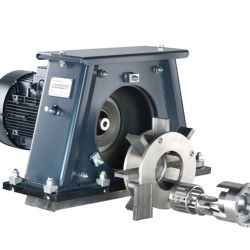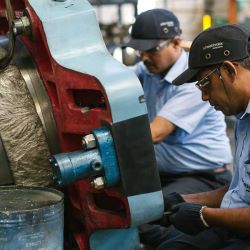Wheelabrator teamed up with Modern Casting magazine to hold a webinar that shows blast machine users how to reduce their cost per part by minimising abrasive consumption. The webinar looked at how tweaks to machine configurations as well as regular inspection, maintenance and upgrades can reduce cost significantly.
The webinar, run by Jonathan Edwards, Wheelabrator Field Market Developer, based in LaGrange, Georgia (US), delivered some of the insights, considerations and tips on how to achieve optimum blast results at the lowest cost per part.
Wheel targeting
According to Jonathan, the single most important thing to optimise and maintain is the accurate targeting of the wheel. In simple terms, this means making sure the abrasive is hitting exactly the right spots on the part, using the feed-in power as efficiently as possible to achieve the desired finish. Optimal targeting then reduces wear, energy use and improves blast results on the part.
A top tip Jonathan gave, and something that can easily be implemented to ensure a wheel is targeted correctly, is to run a two-minute hot spot test using thin gauge steel. The shot will blue the plate and clearly, visibly show if the aim is accurate. A shot machine with accurate targeting will leave an elliptical shape on the plate.
Shot size, mix and maintenance considerations
There is an art and a science to creating the optimum shot recipe. Any deviation, natural or preventable, will have a huge impact on abrasive use and, consequently, production costs.
Size of shot is critical. Smaller abrasive has more impact per pound and provides good coverage. Larger abrasive is good for gross cleaning. Medium particles provide a bit of both. This considered, the ideal solution is a mix that contains shot big enough to break sand and scale – and shot small enough to provide good coverage. Operators should strive for a bell curve of abrasive sizes. The ideal solution may be to select a mix of at least three shot sizes, small, medium and large. This will need to be optimised with due consideration to specific parts.
Once this optimum mix is agreed, it needs to be maintained. Shot has a natural wear life, so once it is spent and filtered out of the cycle, it needs to be replaced. Here, Jonathan recommended an abrasive adder to automate the process of correcting the mix levels and matching them with live requirements.
Wheel, blade and cage configuration
There are lots of moving parts within shot blast machines. If all are running smoothly, optimally and doing their bit to ensure the machine is aiming correctly, internal wear can be minimised.
Abrasive hitting cabinet liners instead of the part is a waste of energy, damages the machine internally and spends shot. It is possible to improve the movement of abrasive through the wheel by optimising and locking the control cage opening angle and by specifying a blade optimised for length, width and shape to achieve a convex shot pattern. Another thing to watch out for is internal components grinding down abrasive. An example of this is shot being violently transitioned from the control cage to the blade. This means the shot is slapped by the blade rather than projected down the length of it, which negatively impacts aim and increases wear both on the abrasive and on internal components. This tends to happen because alignment of the impeller inside the control cage is off-key and therefore stopping abrasive escaping at the right moment.
Checking back in on your optimised configeration
Every single angle, speed, size, component and configuration needs scientific consideration to ensure a machine operates at full efficiency. Once this optimal configuration is achieved, ongoing wear means it doesn’t stay that way, making it essential to regularly check the configuration, alignment and the impact of wear.
A point Jonathan stressed specifically was that unplanned maintenance costs are significantly higher in terms of downtime, disruption, additional staffing and external costs. Planned or predicted maintenance on the other hand can be scheduled to take place at a convenient time, limiting the impact on production schedules.
What next?
Wheelabrator shared many further tips and insights, so we would encourage anybody interested, to watch the webinar.
Finally, operating even close to full efficiency will seldom be achieved solely with in-house expertise. The people who manufacture machines know a lot about them, so be sure to consult with them about how to configure, maintain and upgrade them for maximum, consistent efficiency.
To find out how to maximise the efficiency and performance of your shot blast machine, please contact your local Wheelabrator representative.


